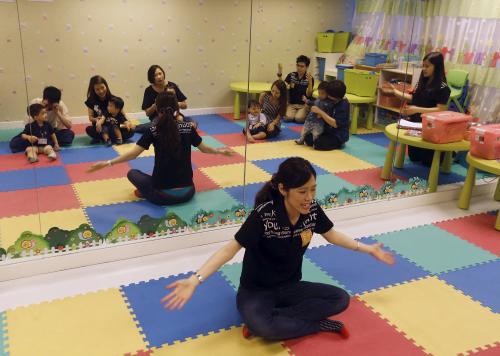“School readiness” seems like a transparent if not hackneyed term. Ask anyone on the street and they will tell you about reading, writing, and ‘rithmetic as the keys to school readiness. Children should go to school knowing the alphabet, how to tie their shoes, and how to count to 20.
Yet, we live in a time of information overload: in 2009, researchers at the University of California-San Diego estimated that adults read the equivalent of 100,000 words, or 83 newspaper articles, every day. Since 1980, our rate of information intake has grown at more than 5 percent per year—a number that pales in comparison to the growth rate of information available for consumption. In 1982, Buckminster Fuller created the knowledge doubling curve to describe the acceleration of humankind’s accumulation of knowledge. In 2013, new knowledge doubled about every 13 months and in 2018, new knowledge is estimated to double almost every day.
To thrive in such an information-rich environment, the range of school readiness skills must include the familiar “basics” but also go beyond them. In other words, the age of information overload forces us to rethink how we define success. In Becoming Brilliant, one of us, Kathy, argues that traditionally, we think of success as preparing students to do well in the testing of basic skills. No doubt this is important. But even more important is a 21st century definition of success that embraces creating: Happy, healthy, thinking, caring, and social children who will become collaborative, creative, competent, and responsible citizens tomorrow.
This 21st century definition requires consideration of a breadth of skills that we call the 6Cs—skills that are grounded in the science, malleable, and measurable. The 6Cs of collaboration, communication, content, critical thinking, creative innovation, and confidence align well with models of workplace needs and discussions about cradle to career growth. They also allow us to think on a broader scale about a breadth of contexts that include enriching school and less traditional informal learning environments like those proposed in the Brookings Learning Landscapes initiative. Finally, this suite of skills works together as a systemic approach to learning such that reading (a content area skill) is completely dependent on communication (strong language skills) which are in turn completely reliant on strong collaboration or social interactive skills.
The 6Cs framework charts out the what of learning. It also forces attention to the how of learning. It is here that scientists are reaching agreement about the power of “learning-to-learn” skills. In a rapidly changing environment, inundated with information overload, learning how to learn is crucial. In fact, the data show that several learning-to-learn skills, which fall under the umbrella term of executive function skills (memory, attention, inhibition, and flexibility), might prove particularly critical for success in many outcomes. For example, the research shows that early mastery of these skills bolsters achievement in reading, writing, and mathematics; but also in social regulation or the ability to control oneself in social situations without lashing out.
Executive function skills can be thought of as three interlocking strengths:
1. Effortless Focus
Effortless focus means learning to focus in a world designed to distract us. Cell phone users quickly notice the texts, rings, and dings that jar us from the task at hand. And the data show that adults and children are not good multi-taskers. In fact, the literature on texting and driving suggests that at most, 2 percent of the population can really do more than one thing at a time. This constant distraction depresses our learning-to-learn skills. But, learning to inhibit distractions elevates this skill. We can train the brain to achieve Effortless Focus by taking time to sound out each of the words children don’t know in a book or staying on target until you reach the closing page of a book. Adults practice effortless focus by continuing to edit a rough draft even though a new e-mail flashes across the screen.
2. Easygoing Filter
The Easygoing Filter allows us to work through misunderstandings and mistakes to maintain and to persist even when material is frustrating. To develop these important skills, young children need opportunities to practice new, more skilled reactions in low stakes environments—especially in collaborative and communicative situations that define their future workplace. Research-based programs in social regulation can help children practice and learn this skill, which is rehearsed every time students need to work in collaborative and communicative settings.
3. Ever Flexible
Finally, learners need to remain Ever Flexible as rules and tools including technology change. Being Ever Flexible depends on maintaining Effortless Focus—as long as one is focusing on the right thing—and using one’s Easygoing Filter to manage the natural human tendency to get stuck in one mindset even when another strategy might be more adaptive. If we can teach children how to adapt Ever Flexible learning strategies, they will be prepared for higher education and workplace settings where humans are still more suited to the task than computers. The ever-flexible child has better problem solving skills and can overcome inevitable challenges using critical thinking and creative innovation. This child also has the persistence and growth mindset that fosters confidence, even in the face of iterative failures.
Cognitive psychologists coined the term Executive Function (EF) after World War II to explain why those with brain damage had difficulty learning and changing their behavior even when current conditions screamed for a new strategy. Exactly what EF is continues to be debated among cognitive and education scientists. But there is consensus that EF competencies form the foundation for learning the suite of skills that will guide children’s success in the 21st century world.
Adding Executive function to the arsenal
On December 10, 2006, Claudia Wallis and Sonja Steptoe wrote a piece for TIME magazine in which they asked what Rip Van Winkle might find familiar after his 100-year nap. Waking up to a world dominated by digital screens and controlled by the internet would be shocking. Yet Van Winkle could take refuge in the fact that schools have not changed. Children still sit in rows with teachers who dispense knowledge and with workbooks that ask them to trace letters.
Today’s version of school readiness does not easily map onto the simplistic notion of ABCs and 123s that prepared children for Rip Van Winkle’s classroom. Today’s children must master content knowledge, plus a suite of skills that are embraced in the 6Cs framework. And if the 6Cs offer the “what” must be learned, EF adds to the child’s arsenal by specifying “how” children learn. The data from studies in the Science of Learning is clear. Our children are growing up in a world in which computers can search better than humans, read better than humans, and do mathematical calculations at a rate unimaginable to humans. Yet, when it comes to social navigation and community building (collaboration), listening and language skills (communication) and even critical thinking and problem solving, computers are a poor second to our species. Our job as educators and caregivers is to prepare children, not for yesterday, but for tomorrow. Now is the time to rethink education and school readiness so that we can dislodge it from the 20th century (or was that the 19th century) model. Incorporating EF into notions of school readiness is one place to start.









Commentary
Meet executive function: How to learn in the age of information overload
March 1, 2018